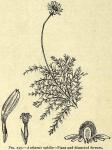Roman Chamomile. English Chamomile.
 The dried flower-heads of Anthe'mis nobil'is Linné, collected from cultivated plants.
The dried flower-heads of Anthe'mis nobil'is Linné, collected from cultivated plants.
SOURCE.—Europe; cultivated in Germany, England (Mitcham Gardens), Surrey; introduced in United States.
DESCRIPTION OF DRUG.—There are two kinds of flower-heads, the single and the double. The latter is developed by cultivation, the disk-florets being partly or wholly converted into the white, strap-shaped, three-toothed ray-florets, forming an almost spherical head, dull white when dry and about 20 mm. (4/5 in.) broad; it is the kind preferred, on account of its greater aromatic properties, which reside in the rays, but as the conversion is more or less incomplete, both kinds may be found intermingled in the commercial article. It is stated, however, by some that the single flowers are more odoriferous and yield a larger proportion of volatile oil; the double flowers, being more showy, are preferred by the public. Involucre imbricate, the scales ovate-oblong, with a scarious margin; receptacle solid, conical, chaffy; odor strong, agreeable; taste aromatic and bitter.
Powder.—Straw color. Characteristic elements: Trichomes, glandular, single-celled, thick-walled; pollen and stomata present.
CONSTITUENTS.—Volatile oil (Oleum Anthemidis, 1 per cent.), at first pale blue, becoming yellowish-brown on exposure; it is regarded as a mixture of hydro carbons with the angelic, valerianic, and tiglinic esters of butyl and amyl. Anthemis also contains a brown, bitter extractive, probably a glucoside. Ash, about 6 per cent.
ACTION AND USES.—Stimulant and tonic, in enfeebled digestion during convalescence; also carminative, and in large doses emetic. Dose: 15 to 60 gr. (1 to 4 Gm.), in infusion.

